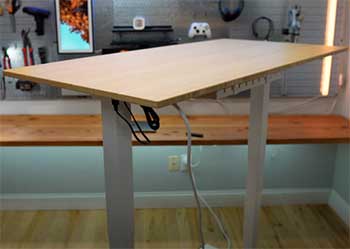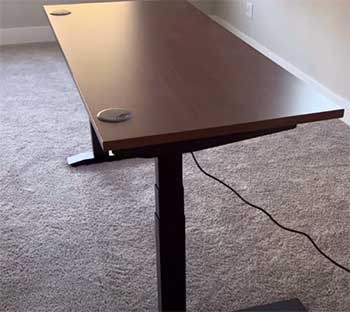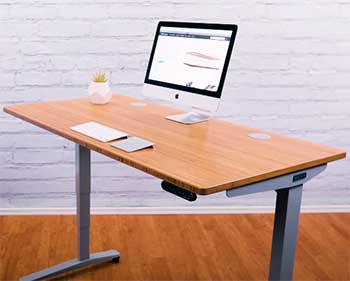When shopping for a new desk, two of the most popular materials are bamboo and laminate. But which one should you choose?
Both have their pros and cons when it comes to factors like durability, style, cost, and environmental impact. This comprehensive guide examines the key differences between bamboo and laminate desks to help you decide which is the right fit for your home or office.
A Brief Comparison Table
| Feature | Bamboo | Laminate |
| Durability | Prone to staining but resists scratches/dents well | Extremely scratch and stain resistant |
| Appearance | Natural blonde wood look with visible grains | Huge range of colors and patterns |
| Eco-Friendliness | Rapidly renewable; pesticide-free growth; biodegradable | Not easily recyclable; higher energy production |
| Cost | $100 – $2000+; affordable low-end options | $80 – $800; great value for large desks |
| Ease of Cleaning | Requires sealing for stain protection; wipes clean | Easy to clean with just damp cloth |
| Workspace Fit | Sleek look fits modern, minimalist decor | Patterns/colors work well for kids rooms or custom spaces |
Overview of Bamboo Desks
Bamboo has become an increasingly popular choice for furniture in recent years, including desks. Here’s a quick rundown of some of the benefits of choosing a bamboo desk:

- Sustainable material – Bamboo is a fast-growing grass that reaches maturity in 3-5 years, compared to 10-20 years for most woods. It is an abundantly renewable resource, often grown without pesticides.
- Attractive visual appeal – Bamboo desks have a clean, contemporary look with noticeable grain patterns. The light color provides a airy, natural feel.
- Sturdy and stable – Bamboo is quite dense and rigid, making desks less prone to warping. High quality bamboo is very durable.
- Affordable option – Basic bamboo desks tend to cost less than solid wood, though high-end bamboo can still be pricey. More budget friendly than many woods.
- Resistant to spills – The smooth surface repels liquid spills that might otherwise stain or damage a wooden desk. Easy to wipe clean.
So in summary, bamboo makes an eco-friendly choice that works well in modern, minimalist decor and provides a sturdy platform for your workspace at an affordable price point for many buyers. But it’s not perfect…
Overview of Laminate Desks
Laminate desks have been popular for many decades, and for some good reasons. Here are some of the advantages of laminate desk surfaces:
- Highly durable – Laminate is made from layers of kraft paper fused with melamine resins. This makes it highly resistant to scrapes, scratches, heat, and stains. The pattern goes all the way through, so it won’t wear away over time.
- Easy to clean – Laminate desks can be cleaned with a wipe of a damp cloth and mild cleaner. No need for special wood treatments or polishes. Spills and messes are easily removed.
- Range of colors/patterns – Laminate comes in every color and pattern under the sun. It’s easy to find an option that matches your decor. Custom laminate patterns are also available.
- Inexpensive – Basic laminate desks tend to be cheaper than solid wood desks. There are even very low cost options that work well for kids’ rooms or home offices on a budget.
So if you want a desk surface that can take abuse and requires little maintenance, laminate is a smart way to go. Of course, there are a few downsides to consider as well…
Key Differences Between Bamboo And Laminate Desk
Durability Comparison
One of the biggest considerations when choosing a new desk is simply how well it will hold up over time. Both bamboo and laminate are durable options, but they have different weak points:
Bamboo Durability
- Dense grain resists dents and scratches
- Stable against warping when properly sealed
- Prone to staining from spills if unsealed
- Can split or crack if imperfections aren’t removed
- Susceptible to fading from prolonged sun exposure
- Harder for gouges and cuts to blend in with the grain pattern
Laminate Durability

- Highly scratch, stain, and scuff resistant
- Durable in high-traffic office settings
- Won’t fade in sunlight
- Damage is less visible thanks to solid color/pattern
- Not prone to cracking or splitting
- Edges may chip or laminate layers separate over time
- Can gradually show wear around high use areas
So bamboo likely has a slight edge for surface-level durability, but laminate stands up better to heavy daily use over many years.
Keep in mind that desk frame construction also impacts sturdiness – cheap legs or supports can undermine the strength of any desktop material.
Appearance Showdown
Beyond just durability, appearance is a major factor that impacts the look and feel of your workspace. Here’s how bamboo and laminate desks compare aesthetically:
Bamboo Style
- Light blonde color with noticeable grain patterns
- Distinct knots and variations add natural character
- Contemporary, minimalist look
- Perceived as more “high end” than laminate
- Stains can detract from appearance
- Color options limited to lighter bamboo shades
Laminate Style
- Huge range of solid colors and patterns
- Seamless look since pattern goes all the way through
- Matte or glossy finishes available
- Beveled edges provide nicely finished look
- Can mimic woodgrain but still looks distinctly “laminate”
- Some laminates can look cheap, while others look crisp and modern
Bamboo’s natural beauty and wood-like appeal wins over many buyers. But for those wanting bright colors or matching patterns, laminate offers endless possibilities for customization. It comes down personal taste and room decor.
Environmental Impact
For the eco-conscious shopper, understanding the environmental pros and cons of these materials is key:
Bamboo Sustainability
- Very renewable resource, matures rapidly
- Often grown pesticide-free
- Biodegradable and recyclable
- Requires less energy to produce than wood
- Some adhesives used in production contain VOCs
- Shipping from Asia increases carbon footprint
Laminate Sustainability
- Not easily recycled or biodegradable
- VOC emissions during production
- Not sustainably sourced
- Typically manufactured in Asia or U.S.
- Lamination process consumes significant energy
- Long lifespans means not often replaced
Bamboo is considered one of the most environmentally friendly commercial wood alternatives. But laminate’s extreme durability means it doesn’t end up in landfills nearly as often. So neither material is a clear winner when it comes to eco-impact.
Cost Comparison
Pricing can also be a significant factor when selecting a desk. Here’s an overview of cost differences:

- Bamboo desks range from $100 on the low end for basic options to $2,000+ for high-end pieces from luxury brands. Mid-range bamboo desks from mass retailers like Wayfair often cost between $250-500.
- Laminate desks start around $80 for budget children’s styles and max out around $800 for large executive desks. For home office and basic workplace needs, expect to spend $150-300 for a quality laminate desk.
There’s overlap in the mid-range pricing, but bamboo edges out laminate for affordability at the lowest price points.
Laminate offers greater value on larger desks for heavy office use.
Making The Right Choice
When choosing between bamboo and laminate desks, consider factors like:
- Workspace size – Will a compact vs. expansive desk be a better fit?
- Usage intensity – Is this a guest room home office or a busy workplace environment?
- Desired look – Do you prefer modern bamboo or customizable laminate patterns?
- Budget – Are you looking for an inexpensive option or willing to pay more for higher end materials?
- Eco-impact – Is sustainability a priority in your purchase?
For many shoppers, the decision ultimately comes down to personal preference on appearance and style. Both bamboo and laminate make smart, durable choices. Do some browsing online or in furniture stores to decide which desk material best suits your needs.
FAQ About Bamboo and Laminate Desks
Still trying to decide between bamboo and laminate for your next desk purchase? Here are answers to some frequently asked questions:
There is no definitive “better” option; each material has pros and cons. Bamboo is more eco-friendly while laminate is extremely durable. Laminate desks feature more color/pattern options. Bamboo has a sleek, natural look. For desks, both are great options that suit different priorities.
Yes, high quality bamboo can make an excellent desk material due to its stability, scratch resistance, and handsome grain patterns. Be sure to seal bamboo desks properly for maximum durability and stain protection. Reputable bamboo desk brands like Anthropologie guarantee their products for up to 25 years.
In terms of resisting heavy daily use and wear-and-tear over many years, laminate is generally the stronger and more durable desktop material. It better withstands potential abuse in busy office environments. But for home office use, bamboo offers comparable durability with more eco-friendly production.
It depends on the wood species, but bamboo does have many advantages: it reaches maturity faster than traditional woods, often lacks chemical treatments, and has more stain and moisture resistance. Bamboo’s density also makes it more resistant to scratches. But quality hardwoods like oak are still seen as premium. Overall, bamboo makes a great eco-friendly alternative to wood for desk construction.
Final Thoughts
Both bamboo and laminate make smart choices for desk surfaces. Consider the trade-offs in appearance, budget, durability, and eco-impact when deciding which option best fits your needs and preferences.
Be sure to also evaluate the overall build quality of the desk frame for maximum stability. With some research, you’re sure to find the perfect desk material for your home office or workspace!

